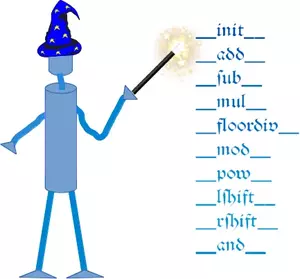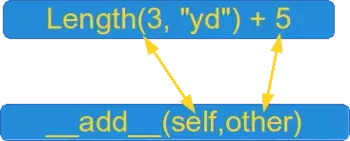7. Magic Methods
By Bernd Klein. Last modified: 04 Dec 2023.
Introduction
The so-called magic methods have nothing to do with wizardry. You have already seen them in the previous chapters of our tutorial. They are special methods with fixed names. They are the methods with this clumsy syntax, i.e. the double underscores at the beginning and the end. They are also hard to talk about. How do you pronounce or say a method name like __init__? "Underscore underscore init underscore underscore" sounds horrible and is almost a tongue twister. "Double underscore init double underscore" is a lot better, but the ideal way is "dunder init dunder" That's why magic methods methods are sometimes called dunder methods!
So what's magic about the __init__ method? The answer is, you don't have to invoke it directly. The invocation is realized behind the scenes. When you create an instance x of a class A with the statement "x = A()", Python will do the necessary calls to __new__ and __init__.

Towards the end of this chapter of our tutorial we will introduce the __call__ method. It is overlooked by many beginners and even advanced programmers of Python. It is a functionality which many programming languages do not have, so programmers generally do not look for it. The __call__ method enables Python programmers to write classes where the instances behave like functions. Both functions and the instances of such classes are called callables.
We have encountered the concept of operator overloading many times in the course of this tutorial. We had used the plus sign to add numerical values, to concatenate strings or to combine lists:
4 + 5
OUTPUT:
9
3.8 + 9
OUTPUT:
12.8
"Peter" + " " + "Pan"
OUTPUT:
'Peter Pan'
[3,6,8] + [7,11,13]
OUTPUT:
[3, 6, 8, 7, 11, 13]

It's even possible to overload the "+" operator as well as all the other operators for the purposes of your own class. To do this, you need to understand the underlying mechanism. There is a special (or a "magic") method for every operator sign. The magic method for the "+" sign is the __add__ method. For "-" it is __sub__ and so on. We have a complete listing of all the magic methods a little further down.
The mechanism works like this: If we have an expression "x + y" and x is an instance of class K, then Python will check the class definition of K. If K has a method __add__ it will be called with x.__add__(y), otherwise we will get an error message:
Traceback (most recent call last): File "", line 1, in TypeError: unsupported operand type(s) for +: 'K' and 'K'
Live Python training
Enjoying this page? We offer live Python training courses covering the content of this site.
Overview of Magic Methods
Binary Operators
| Operator | Method |
|---|---|
| + | object.__add__(self, other) |
| - | object.__sub__(self, other) |
| * | object.__mul__(self, other) |
| // | object.__floordiv__(self, other) |
| / | object.__truediv__(self, other) |
| % | object.__mod__(self, other) |
| ** | object.__pow__(self, other[, modulo]) |
| << | object.__lshift__(self, other) |
| >> | object.__rshift__(self, other) |
| & | object.__and__(self, other) |
| ^ | object.__xor__(self, other) |
| | | object.__or__(self, other) |
Extended Assignments
| Operator | Method |
|---|---|
| += | object.__iadd__(self, other) |
| -= | object.__isub__(self, other) |
| *= | object.__imul__(self, other) |
| /= | object.__idiv__(self, other) |
| //= | object.__ifloordiv__(self, other) |
| %= | object.__imod__(self, other) |
| **= | object.__ipow__(self, other[, modulo]) |
| <<= | object.__ilshift__(self, other) |
| >>= | object.__irshift__(self, other) |
| &= | object.__iand__(self, other) |
| ^= | object.__ixor__(self, other) |
| |= | object.__ior__(self, other) |
Unary Operators
| Operator | Method |
|---|---|
| - | object.__neg__(self) |
| + | object.__pos__(self) |
| abs() | object.__abs__(self) |
| ~ | object.__invert__(self) |
| complex() | object.__complex__(self) |
| int() | object.__int__(self) |
| long() | object.__long__(self) |
| float() | object.__float__(self) |
| oct() | object.__oct__(self) |
| hex() | object.__hex__(self |
Comparison Operators
| Operator | Method |
|---|---|
| < | object.__lt__(self, other) |
| <= | object.__le__(self, other) |
| == | object.__eq__(self, other) |
| != | object.__ne__(self, other) |
| >= | object.__ge__(self, other) |
| > | object.__gt__(self, other) |
Example class: Length
We will demonstrate the Length class and how you can overload the "+" operator for your own class. To do this, we have to overload the __add__ method. Our class contains the __str__ and __repr__ methods as well. The instances of the class Length contain length or distance information. The attributes of an instance are self.value and self.unit.
This class allows us to calculate expressions with mixed units like this one:
2.56 m + 3 yd + 7.8 in + 7.03 cm
The class can be used like this:
from unit_conversions import Length
L = Length
print(L(2.56,"m") + L(3,"yd") + L(7.8,"in") + L(7.03,"cm"))
OUTPUT:
5.57162
The listing of the class:
class Length:
__metric = {"mm" : 0.001, "cm" : 0.01, "m" : 1, "km" : 1000,
"in" : 0.0254, "ft" : 0.3048, "yd" : 0.9144,
"mi" : 1609.344 }
def __init__(self, value, unit = "m" ):
self.value = value
self.unit = unit
def Converse2Metres(self):
return self.value * Length.__metric[self.unit]
def __add__(self, other):
l = self.Converse2Metres() + other.Converse2Metres()
return Length(l / Length.__metric[self.unit], self.unit )
def __str__(self):
return str(self.Converse2Metres())
def __repr__(self):
return "Length(" + str(self.value) + ", '" + self.unit + "')"
if __name__ == "__main__":
x = Length(4)
print(x)
y = eval(repr(x))
z = Length(4.5, "yd") + Length(1)
print(repr(z))
print(z)
OUTPUT:
4 Length(5.593613298337708, 'yd') 5.1148
We use the method __iadd__ to implement the extended assignment:
def __iadd__(self, other):
l = self.Converse2Metres() + other.Converse2Metres()
self.value = l / Length.__metric[self.unit]
return self
Now we are capable of writing the following assignments:
x += Length(1)
x += Length(4, "yd")
We added 1 metre in the example above by writing "x += Length(1))". Most certainly, you will agree with us that it would be more convenient to simply write "x += 1" instead. We also want to treat expressions like "Length(5,"yd") + 4.8" similarly. So, if somebody uses a type int or float, our class takes it automatically for "metre" and converts it into a Length object. It's easy to adapt our __add__ and __iadd__ method for this task. All we have to do is to check the type of the parameter "other":
def __add__(self, other):
if type(other) == int or type(other) == float:
l = self.Converse2Metres() + other
else:
l = self.Converse2Metres() + other.Converse2Metres()
return Length(l / Length.__metric[self.unit], self.unit )
def __iadd__(self, other):
if type(other) == int or type(other) == float:
l = self.Converse2Metres() + other
else:
l = self.Converse2Metres() + other.Converse2Metres()
self.value = l / Length.__metric[self.unit]
return self
It's a safe bet that if somebody works with adding integers and floats from the right side for a while, he or she will want to have the same from the left side! SWhat will happen, if we execute the following code line:
x = 5 + Length(3, "yd")
We will get an exception:
AttributeError: 'int' object has no attribute 'Converse2Metres'
Of course, the left side has to be of type "Length", because otherwise Python tries to apply the __add__ method from int, which can't cope with Length objects as second arguments!
Python provides a solution for this problem as well. It's the __radd__ method. It works like this: Python tries to evaluate the expression "5 + Length(3, 'yd')". First it calls int.__add__(5,Length(3, 'yd')), which will raise an exception. After this it will try to invoke Length.__radd__(Length(3, "yd"), 5). It's easy to recognize that the implementation of __radd__ is analogue to __add__:
def __radd__(self, other):
if type(other) == int or type(other) == float:
l = self.Converse2Metres() + other
else:
l = self.Converse2Metres() + other.Converse2Metres()
return Length(l / Length.__metric[self.unit], self.unit )
It's advisable to make use of the __add__ method in the __radd__ method:
def __radd__(self, other):
return Length.__add__(self,other)
The following diagram illustrates the relationship between __add__ and __radd__:

Live Python training
Enjoying this page? We offer live Python training courses covering the content of this site.
Upcoming online Courses
Standard Classes as Base Classes
It's possible to use standard classes - like int, float, dict or lists - as base classes as well.
We extend the list class by adding a push method:
class Plist(list):
def __init__(self, l):
list.__init__(self, l)
def push(self, item):
self.append(item)
if __name__ == "__main__":
x = Plist([3,4])
x.push(47)
print(x)
OUTPUT:
[3, 4, 47]
This means that all the previously introduced binary and extended assignment operators exist in the "reversed" version as well:
__radd__ , __rsub__ , __rmul__ etc.
Exercises

Exercise 1
Write a class with the name Ccy, similar to the previously defined Length class.Ccy should contain values in various currencies, e.g. "EUR", "GBP" or "USD". An instance should contain the amount and the currency unit. The class, you are going to design as an exercise, might be best described with the following example session:
from currencies import Ccy
v1 = Ccy(23.43, "EUR")
v2 = Ccy(19.97, "USD")
print(v1 + v2)
print(v2 + v1)
print(v1 + 3) # an int or a float is considered to be a EUR value
print(3 + v1)
Live Python training
Enjoying this page? We offer live Python training courses covering the content of this site.
Solutions to our Exercises
Solution to Exercise 1
"""
The class "Ccy" can be used to define money values in various currencies. A Ccy instance has the string attributes 'unit' (e.g. 'CHF', 'CAD' od 'EUR' and the 'value' as a float.
A currency object consists of a value and the corresponding unit.
"""
class Ccy:
currencies = {'CHF': 1.0821202355817312,
'CAD': 1.488609845538393,
'GBP': 0.8916546282920325,
'JPY': 114.38826536281809,
'EUR': 1.0,
'USD': 1.11123458162018}
def __init__(self, value, unit="EUR"):
self.value = value
self.unit = unit
def __str__(self):
return "{0:5.2f}".format(self.value) + " " + self.unit
def changeTo(self, new_unit):
"""
An Ccy object is transformed from the unit "self.unit" to "new_unit"
"""
self.value = (self.value / Ccy.currencies[self.unit] * Ccy.currencies[new_unit])
self.unit = new_unit
def __add__(self, other):
"""
Defines the '+' operator.
If other is a CCy object the currency values
are added and the result will be the unit of
self. If other is an int or a float, other will
be treated as a Euro value.
"""
if type(other) == int or type(other) == float:
x = (other * Ccy.currencies[self.unit])
else:
x = (other.value / Ccy.currencies[other.unit] * Ccy.currencies[self.unit])
return Ccy(x + self.value, self.unit)
def __iadd__(self, other):
"""
Similar to __add__
"""
if type(other) == int or type(other) == float:
x = (other * Ccy.currencies[self.unit])
else:
x = (other.value / Ccy.currencies[other.unit] * Ccy.currencies[self.unit])
self.value += x
return self
def __radd__(self, other):
res = self + other
if self.unit != "EUR":
res.changeTo("EUR")
return res
# __sub__, __isub__ and __rsub__ can be defined analogue
OUTPUT:
Overwriting currencies.py
from currencies import Ccy
x = Ccy(10,"USD")
y = Ccy(11)
z = Ccy(12.34, "JPY")
z = 7.8 + x + y + 255 + z
print(z)
lst = [Ccy(10,"USD"), Ccy(11), Ccy(12.34, "JPY"), Ccy(12.34, "CAD")]
z = sum(lst)
print(z)
OUTPUT:
282.91 EUR 28.40 EUR
Another interesting aspect of this currency converter class in Python can be shown, if we add multiplication. You will easily understand that it makes no sense to allow expressions like "12.4 € * 3.4 USD" (or in prefix notation: "€ 12.4 $ 3.4"), but it makes perfect sense to evaluate "3 4.54 €". You can find the new currency converter class with the newly added methods for __mul__, __imul__ and __rmul__ in the following listing:
"""
The class "Ccy" can be used to define money values in various currencies. A Ccy instance has the string attributes 'unit' (e.g. 'CHF', 'CAD' od 'EUR' and the 'value' as a float.
A currency object consists of a value and the corresponding unit.
"""
class Ccy:
currencies = {'CHF': 1.0821202355817312,
'CAD': 1.488609845538393,
'GBP': 0.8916546282920325,
'JPY': 114.38826536281809,
'EUR': 1.0,
'USD': 1.11123458162018}
def __init__(self, value, unit="EUR"):
self.value = value
self.unit = unit
def __str__(self):
return "{0:5.2f}".format(self.value) + " " + self.unit
def __repr__(self):
return 'Ccy(' + str(self.value) + ', "' + self.unit + '")'
def changeTo(self, new_unit):
"""
An Ccy object is transformed from the unit "self.unit" to "new_unit"
"""
self.value = (self.value / Ccy.currencies[self.unit] * Ccy.currencies[new_unit])
self.unit = new_unit
def __add__(self, other):
"""
Defines the '+' operator.
If other is a CCy object the currency values
are added and the result will be the unit of
self. If other is an int or a float, other will
be treated as a Euro value.
"""
if type(other) == int or type(other) == float:
x = (other * Ccy.currencies[self.unit])
else:
x = (other.value / Ccy.currencies[other.unit] * Ccy.currencies[self.unit])
return Ccy(x + self.value, self.unit)
def __iadd__(self, other):
"""
Similar to __add__
"""
if type(other) == int or type(other) == float:
x = (other * Ccy.currencies[self.unit])
else:
x = (other.value / Ccy.currencies[other.unit] * Ccy.currencies[self.unit])
self.value += x
return self
def __radd__(self, other):
res = self + other
if self.unit != "EUR":
res.changeTo("EUR")
return res
# __sub__, __isub__ and __rsub__ can be defined analogue
def __mul__(self, other):
"""
Multiplication is only defined as a scalar multiplication,
i.e. a money value can be multiplied by an int or a float.
It is not possible to multiply to money values
"""
if type(other)==int or type(other)==float:
return Ccy(self.value * other, self.unit)
else:
raise TypeError("unsupported operand type(s) for *: 'Ccy' and " + type(other).__name__)
def __rmul__(self, other):
return self.__mul__(other)
def __imul__(self, other):
if type(other)==int or type(other)==float:
self.value *= other
return self
else:
raise TypeError("unsupported operand type(s) for *: 'Ccy' and " + type(other).__name__)
OUTPUT:
Overwriting currency_converter.py
Assuming that you have saved the class under the name currency_converter, you can use it in the following way in the command shell:
from currency_converter import Ccy
x = Ccy(10.00, "EUR")
y = Ccy(10.00, "GBP")
x + y
OUTPUT:
Ccy(21.215104685942173, "EUR")
print(x + y)
OUTPUT:
21.22 EUR
print(2*x + y*0.9)
OUTPUT:
30.09 EUR
Footnotes
- as suggested by Mark Jackson
Live Python training
Enjoying this page? We offer live Python training courses covering the content of this site.
Upcoming online Courses
